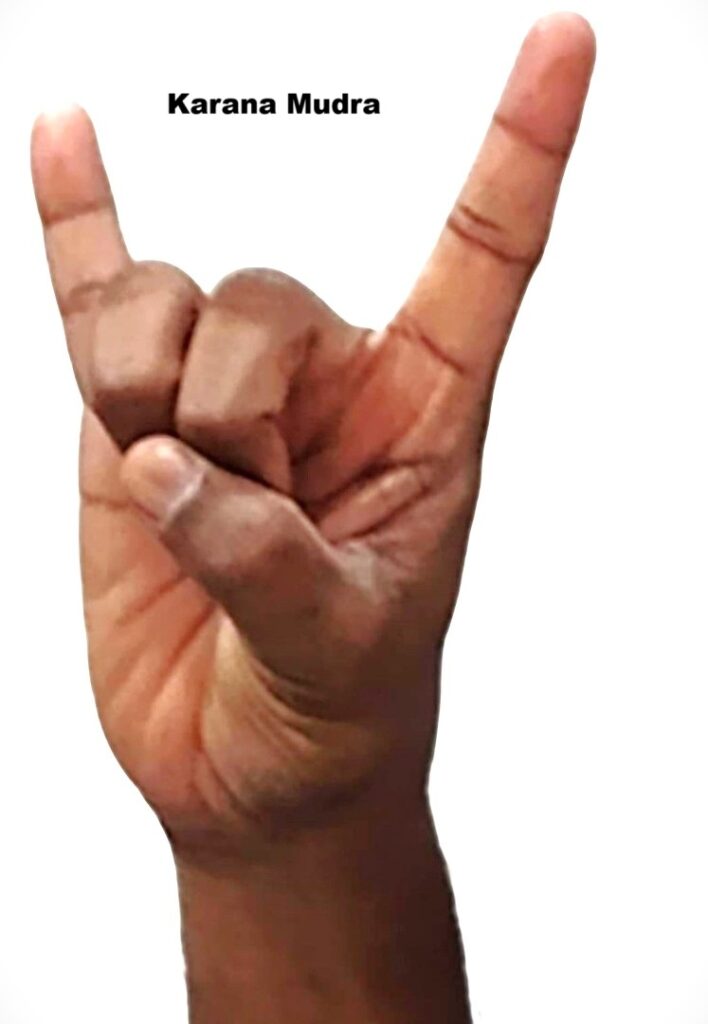Karana Mudra
Introduction
Karana Mudra is one of the hasta mudras (hand gestures) found in yoga, Buddhism, and Indian dance traditions. It is primarily known as a protective gesture used to ward off negativity, fear, and illness. The mudra is depicted in ancient Buddhist and Hindu iconography, where deities and enlightened beings use it to dispel evil forces and obstacles on the spiritual path.
It is sometimes called the “Gesture of Banishing Negativity”, and is believed to be particularly powerful in meditation and healing practices.
Meaning
Sanskrit: “Karana” means to do, to cause, or to effect.
Symbolically, it is the gesture of expelling demons, removing obstacles, and dissolving negativity.
Energetically, it signifies cleansing, protection, and transformation of negative energies into positive flow.
How to Perform (Method of Practice)
Step-by-Step:
Sit comfortably in Sukhasana, Vajrasana, or Padmasana, keeping the spine straight.
Extend the index and little finger upward.
Curl the middle and ring fingers inward toward the palm.
Press them down gently with the thumb.
The hand resembles the “horns” gesture often seen in sacred art.
Hold the mudra at chest or shoulder level while focusing on breath awareness and protection from negativity.
Practice with closed eyes, inhaling calmness and exhaling negativity.
Benefits
Physical Benefits
Helps relieve tension, stress, and fatigue.
Boosts the immune system by reducing psychosomatic stress.
Balances respiratory and circulatory systems.
Mental & Emotional Benefits
Dispels fear, anxiety, and depression.
Promotes courage, clarity, and confidence.
Helps in releasing negative emotions, resentment, or anger.
Spiritual Benefits
Protects against negative energies in meditation or spiritual practice.
Enhances concentration and inner strength.
Invokes higher vibrations, aiding in transformation.
Contraindications
Not suitable if practiced aggressively (should be done with calm focus).
Avoid prolonged holding if you have finger stiffness, arthritis, or nerve pain.
Should not be used with an intention of aggression, as it is meant for protection, not hostility.
Anatomy & Physiology
Involves flexion of middle and ring fingers while keeping index and little finger extended.
Engages intrinsic hand muscles and flexor tendons.
Creates neural feedback to the parasympathetic nervous system, reducing stress.
Influences thoracic breathing patterns by calming the diaphragm and chest muscles.
Kinesiology
The isometric contraction of hand muscles supports stability of the wrist.
The positioning strengthens lumbricals, flexors, and extensors of the fingers.
Shoulder and chest muscles remain relaxed, encouraging postural alignment.
Neurology
Stimulates median, radial, and ulnar nerves.
Activates the somatosensory cortex (hand region), improving awareness.
Promotes neuroplastic relaxation pathways to replace fear with calmness.
Enhances limbic system regulation, helping to control negative emotional responses.
Duration of Practice
Beginners: 5–10 minutes daily.
Intermediate/Advanced: 15–30 minutes in meditation.
Can be practiced during stressful situations, or before/after meditation for cleansing.
Counter Mudra
Abhaya Mudra (gesture of fearlessness, open palm outward).
Hridaya Mudra (gesture for emotional healing).
Chin Mudra (gesture of consciousness, for centering and peace).
Conclusion
Karana Mudra is a powerful protective and cleansing hand gesture. It symbolizes the banishing of negativity, fear, and obstacles while enhancing courage, clarity, and peace. By activating both the mind and body’s protective mechanisms, it helps practitioners stay grounded, fearless, and spiritually aligned.
It is not only a yogic practice but also a symbolic gesture in Buddhism and Hinduism, representing the ability to transform fear into freedom.
FAQ
Q1: Is Karana Mudra the same as the “horns” gesture?
Yes, but its meaning in yoga/spirituality is sacred (banishing negativity), unlike its modern casual uses.
Q2: Can I practice this mudra during meditation?
Yes, it enhances protection and concentration during meditation.
Q3: Does Karana Mudra really remove negative energy?
It works on a psychological and energetic level, helping you feel protected, calm, and fearless.
Q4: Can children practice this mudra?
Yes, but for shorter durations (3–5 minutes).
Q5: Which chakra does Karana Mudra influence?
It primarily works with the Muladhara (Root Chakra) and Anahata (Heart Chakra) for grounding and protection.
References
Swami Satyananda Saraswati – Asana, Pranayama, Mudra, Bandha.
Gertrud Hirschi – Mudras: Yoga in Your Hands.
Joseph Campbell – The Mythic Image (Buddhist mudras context).
Vasant Lad – The Science of Self-Healing.
Mallinson & Singleton – Roots of Yoga.
